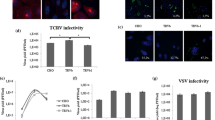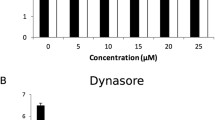Abstract
In the present work we used various cell lines in order to study the possible effect of coxsackievirus B3 (CVB3) entry on the adenylyl cyclase transmembrane signalling system. A significant decrease (by about 10–20%) was found in forskolin-augmented as well as in AlF −4 - and GTPγS-sensitive adenylyl cyclase activity in plasma membranes isolated from HeLa, HEp-2, Vero and green monkey kidney cells shortly (up to 60 min) preincubated with CVB3 (5 PFU/cell). Moreover, the ability of G-proteins derived from plasma membranes of infected cells to reconstitute AC activity in the cyc− mutant of S49 cells was also reduced. Content of G-protein subunits, however, remained unchanged after CVB3 attachment. Functional alterations in the G-protein-mediated adenylyl cyclase signalling system were accompanied by a marked decrease (by about 20–40%) of intracellular cAMP levels in virus-affected cells. These findings demonstrate clearly that CVB3 may affect functioning of the G-protein regulated adenylyl cyclase transmembrane signalling system in virus-sensitive cells as early as during the first period of its contact with the cellular plasma membrane.
Similar content being viewed by others
References
Birnbaumer, L., Abramowitz, J. and Brown A. (1990) Receptor-effector coupling by G proteins.Biochim. Biophys. Acta 1031:163–224.
Spiegel A. M., Shenker A. and Weinstein L. S. (1992) Receptor-effector coupling by G proteins: implications for normal and abnormal signal transduction.Endocr. Rev. 13:536–565.
Gilman, A. G. (1987) G proteins: transducers of receptor-generated signals. Annu. Rev. Biochem.56:615–649.
Birnbaumer, L. (1992) Receptor-to-effector signaling through G proteins: roles for βγ dimers as well as subunits.Cell 71:411–418.
Tang, W. J., Iniguez-Lluhi, J. A., Mumby, S. and Gilman, A. G. (1992) Regulation of mammalian adenylyl cyclases by G-protein α and βγ subunits.Cold Spring Harbour Symp. Quant. Biol. 57:135–144.
Iyengar, R. (1993) Molecular and functional diversity of mammalian G5-stimulated adenylyl cyclases.FASEB J. 7:768–775.
Cook, S. J. and McCormick, F. (1993) Inhibition of cAMP of Ras-dependent activation of Raf.Science 262:1069–1072
Weingarten, R., Ransnäs, L. A., Mueller, H. M., Sklar, L. A. and Bokoch, G. M. (1990) Mastoparan interacts with carboxyl terminus of the α subunit of Gi.J. Biol. Chem. 265:11044–11049.
Nagy, L. E. and DeSilva, S. (1992) Ethanol increases receptor-dependent cyclic AMP production in cultured hepatocytes by decreasing Gimediated inhibition.Biochem. J. 286:681–686.
Mukai, H., Munekata, E. and Higashijima, T. (1992) G protein antagonists: a novel hydrophobic peptide competes with receptor for G protein binding.J. Biol. Chem. 267:16237–16243.
Kupper, R. W., Dewald, B., Jakobs, K. H., Baggiolini, M. and Gierschik, P. (1992) G-protein activation by interleukin 8 and related cytokines in human neutrophil plasma membranes.Biochem. J. 282:429–434.
Bueb, J. L., DaSilva, A., Mousli, M. and Landry, Y. (1992) Natural polyamines stimulate G-proteins.Biochem. J. 280:545–550.
Bishop, J. M. (1983) Cellular oncogenes and retroviruses.Annu. Rev. Biochem. 52:301–354.
Klein, G. and Klein, E. (1985) Evolution of tumor and impact of molecular oncology.Nature 315:190–195.
Whitfield, J. F., Durkin, J. P., Franks, D. J., Kleine, D. J., Raptis L., Rixon, R. H., Sikorska, M. and Walker, P. R. (1987) Calcium, cyclic AMP and protein kinase C-partners in mitogenesis.Canc. Methastasis Rev. 5:205–250.
O'Brian, C. A. and Ward, N. E. (1989) Biology of the protein kinase C family.Canc. Methastasis Rev. 8:199–214.
Landis, C. A., Masters, S. B., Spada, A., Pace, A. M., Bourne, H. R. and Vallar, L. (1989) GTPase inhibiting mutations activate the α chain of G5 and stimulate adenylyl cyclase in human pituitary tumours.Nature 340:692–696.
Ross, E. M. (1990) Viral hijack of receptors.Nature 344:707–708.
Allen, L. F., Lefkowitz, R. J., Caron, M. G. and Catecchia, S. (1991) G-protein-coupled receptor genes as protooncogenes: constitutively activating mutation of the α1B-adrenergic receptor enhances mitogenesis and tumorogenicity.Proc. Natl. Acad. Sci. USA 88:11354–11358.
Spada, A., Vallar, L. and Giovanni, F. (1992) G protein oncogenes in pituitary tumors.TEM 3:355–360.
Donta, S. T. and Shanley, J. D. (1990) Reovirus type 3 binds to antagonist domains of the β-adrenergic receptor.J. Virol. 64:639–641.
Hanham, C. A., Zhao, F. and Tignor, G. H. (1993) Evidence from the anti-idiotypic network that the acetylcholine receptor is a rabies virus receptor.J. Virol. 67:530–542.
Chee, M. S., Satchwell, S. C., Preddie, E. Weston, K. M. and Barrel, B. G. (1990) Human cytomegalovirus encodes three G protein-coupled receptor homologues.Nature 344:774–777.
Nicholas, J., Cameron, K. R. and Honess, R. W. (1992) Herpesvirus saimiri encodes homologues of G protein-coupled receptors and cyclins.Nature 355:362–365.
Melnick, J. L. (1969) Enteroviruses. In:Diagnostic Procedures for Viral and Rickettsial Infections (Melnick, J. L., ed.) pp. 529–602, Am. Publ. Health. Assoc., New York.
Beck, M. and Tracy, S. M. (1989) Murine Cell-mediated response recognizes an enterovirus group-specific antigen.J. Virol. 63:4148–4156.
Johnson, R. A. and Salomon, Y. (1991) Assay of adenylyl cyclase catalytic activity. In:Methods in Enzymology, vol. 195, Adenylyl Cyclase, G Proteins, and Guanylyl Cyclase (Johnson, R. A. and Corbin, J. D., eds.) Academic Press, London pp. 1–21.
Ross, E. M. and Gilman, A. G. (1977) Resolution of some components of adenylate cyclase necessary for catalytic activity.J. Biol. Chem. 252:6966–6969.
Laemmli, U. K. (1970) Cleavage of structural proteins during the assembly of the head of bacteriophage T4.Nature 227:680–685.
Mumby, S. M., Kahn, R. A., Manning, D. R. and Gilman, A. G. (1986) Antisera of designed specificity for subunits of guanine nucleutide-binding regulatory proteins.Proc. Natl. Acad. Sci. U.S.A. 83:265–269.
Lowry, O. H., Rosebrough, N. J., Farr, A. L. and Randall, R. J. (1951) Protein measurement with Folin phenol reagent.J. Biol. Chem. 52:598–605.
Reagan, K. J., Goldberg, B. and Crowell, R. L. (1984) Altered receptor specificity of coxsackievirus B3 after growth in rhabdomyosarcoma cells.J. Virol. 49:635–640.
Schmidt, N. J., Ho, H. H. and Lennette, E. H. (1975) Propagation and isolation of group A coxsackieviruses in RD cells.J. Clin. Microbiol. 2:183–185.
Crowell, R. L. (1966) Specific cell-surface alteration by enteroviruses as reflected by viral-attachment interference.J. Bacteriol. 91:198–204.
Hsu, K. -H. L., Lonberg-Holm, K., Alstein, B. and Crowell, R. L. (1988) A monoclonal antibody specific for the cellular receptor for group B coxsackieviruses.J. Virol. 65:1647–1652.
Cao, Y., Walen, K. H. and Schnurr, D. (1988) Coxsackievirus B-3 selection of virus resistant Buffalo green monkey kidney cells and chromosome analysis of parental and resistant cells.Arch. Virol. 101:209–219.
Sun, G., Zhang, T., Han, Y., Chen, H., Ma, G. and Cui, X. (1989)Murine myocardial cell infection induced by coxsackie virus B3 In: Pathogenesis and Control of Viral Infections (Aiuti, F., ed.) Raven Press Ltd., New York. pp. 96–104.
Author information
Authors and Affiliations
Rights and permissions
About this article
Cite this article
Novotny, J., Kvapil, P., Cello, J. et al. Coxsackievirus B3 entry into the host cell interferes with G-protein-mediated transmembrane signalling. Biosci Rep 14, 205–214 (1994). https://doi.org/10.1007/BF01200249
Received:
Issue Date:
DOI: https://doi.org/10.1007/BF01200249




